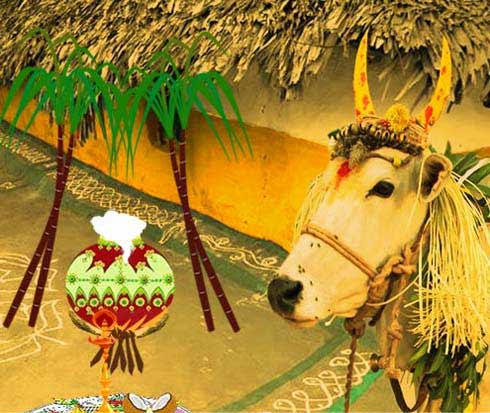Thai Pongal, an agrarian festival, is one of the most important Tamil festivals and is observed in the Tamil Month Thai. Pongal 2025 date is January 14. Pongal takes its name from the famous traditional Tamilian food of the same name and is dedicated to Lord Surya or the Sun God. The festival is also known as Surya Pongal and Perum Pongal. The festival symbolically signifies prosperity.
History Of Pongal Festival
Thai Pongal is an ancient Tamil festival and its roots can be traced back to the Sangam Period (200 B.C.). The festival is also referred as Makar Sankranti and is observed on the first day of the Tamil month Thai.
Importance of Pongal
Pongal is among the best known festivals and certainly one of the major festivals in Tamil
Pongal is an ancient festival and its origin can be traced back to the Sangam Era (200 BC – 300 AD).
The entire festival even today maintains the Dravidian practices and is untouched by external influences.
The entire festival even today maintains the Dravidian practices and is untouched by external influences.
Thai Pongal is a four-day festival.
- The first day is Bhogi Pongal, it is observed on the last day of the Margazhi month.
- The second day is Pongal or Thai Pongal or Perum Pongal and is the most important day.
- The third day is Mattu Pongal.
- The fourth and final day of celebration is Kaanum Pongal.
How is Pongal Observed?
- Pongal is also essentially an agrarian festival.
- For Pongal, houses are freshly painted, swept and cleared.
- Doorways are marked with kumkum, turmeric and sandalwood paste.
- Colorful garlands of flowers and mango leaves are hung on the doors.
- The courtyard in front of each home is decorated with Pongal kolams – designs in white rice powder bordered with red clay.
- On the day, people worship the Sun God (Lord Surya or Suryan).
- Fresh farm products including sugarcane, turmeric, and coconut are arranged on plantain leaves and kept near the kolam.
- Offerings are made to Lord Surya, Ganesha, and other gods.
- Domesticated animals are bathed, a new rope is tied and they are given fresh food and sweets.
The most important event of the day is the cooking of Pongal dish, which is done during the auspicious moment when the Thai month begins. The Pongal is prepared in a fresh earthen vessel, which is adorned with flowers, turmeric leaves, and roots.
The first prepared Pongal on the day is offered to Surya and each of its auspicious ingredients has a symbolic meaning. Milk and rice are the signs of prosperity, sugarcane of sweetness and turmeric augurs the good things to come.
South India , especially in Tamil Nadu, Telangana, Andhra Pradesh and parts of Karnataka. Pongal, or sometimes referred as Pongali, is prepared using fresh farm produce, sugarcane, rice, dal, jaggery, grapes, dry fruits, sugar, and milk. All these ingredients are cooked in a pot in the open and allowed to boil over. The cooking of the Pongal dish signifies plenty and prosperity for the year ahead.
The first prepared Pongal on the day is offered to Surya and each of its auspicious ingredients has a symbolic meaning. Milk and rice are the signs of prosperity, sugarcane of sweetness and turmeric augurs the good things to come.
Why is Pongal Cooked and Offered?
On Pongal and Sankranti day, cooking a sweet rice preparation is must for Hindus in
This first preparation is offered to Lord Surya or the Sun God as Naivedya – It is a sort of thanksgiving to Surya whose energy is used to cultivate the food that we eat.
Farmers observe this ritual for a good harvest in the coming season.
Related
How to do Thai Pongal Puja?Why is sugarcane a must during Pongal?

